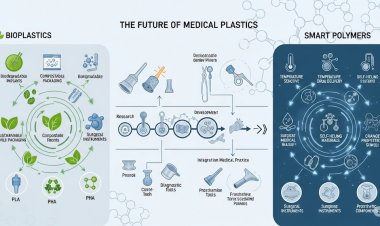Biofertilizers Market Analysis 2025: Growth, Trends, and Future Opportunities
Explore the global biofertilizers market with insights on growth projections, key drivers, challenges, regional trends, product segmentation, major players, technological advancements, and consumer adoption.

The Global Biofertilizers Market has witnessed remarkable growth over the past decade, reflecting a paradigm shift in agricultural practices and a growing emphasis on sustainability. According to analysts at Vantage Market Research, the market was valued at USD 2,649.23 million in 2022 and is projected to reach USD 6,017.81 million by 2030, registering a robust compound annual growth rate (CAGR) of 10.80% over the forecast period. This trajectory is further supported by other industry estimates, which place the market size at approximately USD 2.8 billion in 2022, with expectations to surpass USD 5.2 billion by 2030, maintaining a CAGR of around 10.9%. Such consistent growth underscores the increasing adoption of biofertilizers as a viable alternative to conventional chemical fertilizers, driven by both environmental and economic imperatives.
The expansion of the biofertilizers market is not merely a reflection of increased demand but also of the evolving regulatory landscape and consumer preferences. As governments worldwide implement stricter regulations on chemical fertilizer usage due to their adverse environmental impacts, biofertilizers have emerged as a preferred solution for sustainable crop production. The market’s growth is also fueled by the rising cost of synthetic fertilizers, which has prompted farmers to seek cost-effective and eco-friendly alternatives. Furthermore, the global push towards organic farming and the increasing awareness of soil health have contributed significantly to the market’s upward trajectory.
Another critical factor contributing to the market’s growth is the advancement in research and development activities, leading to the introduction of innovative biofertilizer products with enhanced efficacy and shelf life. Companies are investing heavily in developing formulations that cater to a wide range of crops and climatic conditions, thereby expanding their market reach. The integration of biofertilizers with precision agriculture technologies has also played a pivotal role in optimizing their application and improving crop yields, further bolstering market growth.
In summary, the biofertilizers market is poised for substantial growth in the coming years, driven by a confluence of regulatory, economic, and technological factors. The projected increase in market size from USD 2.8 billion to USD 5.2 billion by 2030, at a CAGR of approximately 10.9%, highlights the sector’s resilience and its critical role in shaping the future of sustainable agriculture.
Key Takeaways
- The global biofertilizers market is experiencing rapid growth, projected to rise from USD 2.8 billion in 2022 to USD 5.2 billion by 2030, with a CAGR of about 10.9%.
- Market expansion is driven by the increasing focus on sustainable agriculture and the need to reduce environmental impacts from chemical fertilizers.
- Precision farming techniques and digital agriculture are enhancing the targeted and efficient use of biofertilizers.
- Government initiatives, subsidies, and regulatory support worldwide are encouraging the adoption of biofertilizers.
- Consumer demand for organic and pesticide-free food is influencing farmers to switch to biofertilizers.
- Nitrogen-fixing biofertilizers are the dominant product segment, with seed treatment being the most common application method.
- Both dry and liquid biofertilizer formulations are widely used, each offering unique benefits in terms of shelf life and application.
- The market faces challenges such as limited shelf life, risks of contamination, and strong competition from established synthetic fertilizers.
- North America leads the market in terms of size and innovation, while Asia Pacific and Africa are emerging as high-growth regions due to government support and agricultural needs.
- Europe is notable for its strong regulatory backing and sustainability standards for biofertilizer use.
- Major industry players like Novozymes and UPL are expanding through R&D, partnerships, and acquisitions, fostering innovation and market reach.
- Future opportunities include the rise of organic farming, urban agriculture, and the development of advanced biofertilizer formulations.
- Technological advancements, especially in biotechnology and microbial research, are improving the efficacy and stability of biofertilizers.
- Farmer education, outreach programs, and demonstration projects are crucial for increasing awareness and adoption, especially among smallholder farmers.
- Overcoming barriers such as farmer skepticism and ensuring consistent product performance across diverse conditions are essential for broader market penetration.
Key Drivers of Market Growth
The biofertilizers market is being propelled by several key drivers, chief among them being the increasing focus on sustainable agriculture. As the global population continues to rise, the demand for food production intensifies, placing immense pressure on agricultural systems. Traditional farming practices, heavily reliant on chemical fertilizers, have led to soil degradation, water pollution, and a decline in biodiversity. In response, there is a growing consensus among policymakers, industry stakeholders, and consumers on the need to adopt sustainable agricultural practices that preserve natural resources and ensure long-term food security. Biofertilizers, which harness the power of naturally occurring microorganisms to enhance soil fertility and plant growth, are at the forefront of this movement.
The adoption of precision farming techniques is another significant driver of market growth. Precision agriculture leverages advanced technologies such as GPS, remote sensing, and data analytics to optimize the use of inputs, including fertilizers. By integrating biofertilizers into precision farming systems, farmers can achieve targeted application, reduce wastage, and improve crop yields. This synergy between biofertilizers and precision agriculture not only enhances productivity but also minimizes the environmental footprint of farming operations.
Government initiatives promoting the use of biofertilizers have also played a crucial role in market expansion. Many countries have introduced subsidies, tax incentives, and awareness campaigns to encourage farmers to transition from chemical to biological fertilizers. For instance, the Indian government’s National Mission for Sustainable Agriculture includes specific provisions for the promotion of biofertilizers, while the European Union’s Common Agricultural Policy supports the adoption of environmentally friendly farming practices. These policy measures have created a conducive environment for the growth of the biofertilizers market, providing both financial and technical support to farmers.
Consumer awareness and changing preferences are further driving the demand for biofertilizers. With increasing concerns about food safety and the health risks associated with chemical residues, consumers are seeking organically grown produce. This shift in consumer behavior has prompted farmers to adopt biofertilizers as part of their organic farming practices, thereby expanding the market.
In conclusion, the growth of the biofertilizers market is underpinned by a combination of sustainability imperatives, technological advancements, supportive government policies, and evolving consumer preferences. These drivers are expected to continue shaping the market landscape, fostering innovation and adoption across the agricultural value chain.
Market Challenges and Constraints
Despite the promising growth prospects, the biofertilizers market faces several challenges and constraints that could impede its expansion. One of the primary challenges is the limited shelf life of biofertilizer products. Unlike chemical fertilizers, which can be stored for extended periods without significant loss of efficacy, biofertilizers contain living microorganisms that are sensitive to environmental conditions such as temperature, humidity, and exposure to light. This sensitivity can lead to a decline in the viability and effectiveness of the product over time, posing logistical challenges for manufacturers, distributors, and end-users.
Risks of contamination during storage and transport further exacerbate the issue of limited shelf life. Biofertilizers are susceptible to contamination by unwanted microorganisms, which can compromise their quality and performance. Ensuring the purity and stability of biofertilizer products requires stringent quality control measures throughout the supply chain, from production to application. This adds to the complexity and cost of biofertilizer manufacturing and distribution, particularly in regions with inadequate infrastructure.
Another significant constraint is the dominance of synthetic fertilizers in the global market. Chemical fertilizers have been the backbone of modern agriculture for decades, offering immediate and predictable results. Their widespread availability, established distribution networks, and farmer familiarity make it challenging for biofertilizers to gain a foothold, especially in regions where awareness and education about biological alternatives are limited. Overcoming this entrenched preference for synthetic fertilizers requires concerted efforts in farmer education, demonstration of biofertilizer efficacy, and the development of cost-competitive products.
Regulatory hurdles also pose challenges to market growth. The registration and approval process for biofertilizer products can be lengthy and complex, varying significantly across countries. Inconsistent regulatory frameworks and lack of harmonization can create barriers to market entry and limit the availability of biofertilizers in certain regions.
Lastly, the variability in biofertilizer performance under different agro-climatic conditions can affect farmer confidence and adoption rates. Unlike chemical fertilizers, whose effects are relatively uniform, the efficacy of biofertilizers can be influenced by factors such as soil type, crop species, and environmental conditions. Addressing these challenges requires ongoing research and development to create robust, adaptable biofertilizer formulations.
In summary, while the biofertilizers market holds significant promise, addressing challenges related to shelf life, contamination risks, competition from synthetic fertilizers, regulatory barriers, and performance variability is essential for sustained growth and widespread adoption.
Regional Market Dynamics and Trends
The global biofertilizers market exhibits distinct regional dynamics, shaped by varying levels of technological adoption, regulatory support, and agricultural practices. North America stands out as a leading market segment, driven by a strong emphasis on sustainable agriculture, advanced research and development capabilities, and supportive government policies. The United States, in particular, has witnessed significant adoption of biofertilizers, fueled by the organic farming movement and increasing consumer demand for pesticide-free produce. The presence of major industry players and a well-established distribution network further bolster the market in this region.
In contrast, the Asia Pacific region represents one of the fastest-growing markets for biofertilizers, propelled by the need to enhance agricultural productivity and address soil degradation issues. Countries such as India and China are at the forefront of this growth, supported by large agricultural sectors, government initiatives, and a growing awareness of the benefits of biofertilizers. In India, for example, the government’s focus on doubling farmers’ income and promoting sustainable agriculture has led to increased investment in biofertilizer production and distribution. The region’s diverse agro-climatic conditions also provide opportunities for the development and application of a wide range of biofertilizer products.
Africa, though still an emerging market, holds significant potential for biofertilizer adoption. The continent faces challenges such as declining soil fertility, limited access to chemical fertilizers, and the need to improve food security. Biofertilizers offer a cost-effective and sustainable solution to these challenges, and several international organizations and NGOs are working to promote their use among smallholder farmers. However, limited infrastructure, lack of awareness, and regulatory hurdles remain barriers to widespread adoption.
Europe is characterized by strong regulatory support for biofertilizers, driven by the European Union’s commitment to reducing the environmental impact of agriculture. The EU’s Common Agricultural Policy and the Farm to Fork Strategy emphasize the use of sustainable inputs, including biofertilizers, to achieve climate and biodiversity goals. As a result, the region has seen increased investment in research, product development, and farmer education. Countries such as Germany, France, and Italy are leading the way in biofertilizer adoption, supported by robust certification and quality assurance systems.
In summary, regional market dynamics are shaped by a combination of policy frameworks, technological capabilities, and agricultural needs. North America leads in market size and innovation, Asia Pacific and Africa offer significant growth opportunities, and Europe sets the benchmark for regulatory support and sustainability standards. Understanding these regional trends is crucial for stakeholders seeking to capitalize on the global biofertilizers market.
Product Segmentation and Features
The biofertilizers market is characterized by a diverse range of products, each designed to address specific crop and soil requirements. Among the various types of biofertilizers, nitrogen-fixing biofertilizers dominate the market, owing to their critical role in enhancing soil fertility and promoting plant growth. These biofertilizers contain microorganisms such as Rhizobium, Azotobacter, and Azospirillum, which convert atmospheric nitrogen into a form that plants can readily absorb. Nitrogen-fixing biofertilizers are particularly beneficial for leguminous crops, but their application has expanded to a wide range of cereals, vegetables, and fruits.
Phosphate-solubilizing biofertilizers represent another important segment, addressing the challenge of phosphorus availability in soils. These products contain microorganisms that release organic acids, solubilizing insoluble phosphates and making them accessible to plants. Potassium-mobilizing and multi-nutrient biofertilizers are also gaining traction, offering comprehensive solutions for balanced plant nutrition.
In terms of application methods, seed treatment is the most widely adopted approach, allowing for the direct inoculation of seeds with beneficial microorganisms. This method ensures early colonization of the plant root system, enhancing nutrient uptake and disease resistance. Other application methods include soil treatment, where biofertilizers are applied directly to the soil, and foliar application, which involves spraying biofertilizer solutions onto plant leaves.
A key consideration in product selection is the choice between dry and liquid formulations. Dry biofertilizers, typically in powder or granular form, offer ease of handling and longer shelf life under appropriate storage conditions. They are well-suited for large-scale agricultural operations and regions with limited access to refrigeration. Liquid biofertilizers, on the other hand, provide higher microbial counts and faster action, making them ideal for precision application and high-value crops. However, they require careful storage and handling to maintain microbial viability.
The development of carrier-based biofertilizers, which use materials such as peat, lignite, or vermiculite to support microbial growth, has further enhanced product stability and ease of application. Innovations in encapsulation and slow-release technologies are also being explored to improve the efficacy and shelf life of biofertilizer products.
In conclusion, the biofertilizers market offers a wide array of products tailored to different crops, soils, and farming practices. The dominance of nitrogen-fixing biofertilizers, the prevalence of seed treatment as an application method, and the ongoing innovation in formulation technologies underscore the market’s adaptability and potential for growth.
Competitive Landscape and Major Players
The competitive landscape of the biofertilizers market is marked by the presence of both established multinational corporations and emerging regional players, each vying for a share of the rapidly expanding market. Key market participants such as Novozymes, UPL Limited, Lallemand Inc., and Symborg have established themselves as leaders through extensive research and development, robust distribution networks, and strategic partnerships.
Novozymes, a global leader in biological solutions, has been at the forefront of biofertilizer innovation, leveraging its expertise in enzyme and microbial technologies to develop high-performance products. The company’s focus on sustainability and collaboration with agricultural stakeholders has enabled it to maintain a strong market position. UPL Limited, another major player, has expanded its biofertilizer portfolio through acquisitions and partnerships, targeting both developed and emerging markets. The company’s integrated approach, combining crop protection and nutrition solutions, has resonated with farmers seeking comprehensive agricultural inputs.
Lallemand Inc. and Symborg are also notable players, with a strong emphasis on research-driven product development and farmer education. These companies have invested in state-of-the-art production facilities and quality assurance systems to ensure the efficacy and safety of their biofertilizer products.
Market expansion strategies among leading companies include mergers and acquisitions, product diversification, and geographic expansion. For instance, several companies have entered into joint ventures and collaborations with local distributors and research institutions to enhance their market presence and adapt products to regional needs. Partnerships with government agencies and non-governmental organizations have also facilitated the dissemination of biofertilizer technologies, particularly in developing countries.
Trends in partnerships and collaborations are shaping the competitive landscape, with companies increasingly recognizing the value of cross-sectoral alliances. Collaborations with technology providers, academic institutions, and farmer cooperatives are enabling the development of innovative products and the scaling of distribution networks. These partnerships are also instrumental in addressing challenges related to farmer education, product demonstration, and regulatory compliance.
In summary, the biofertilizers market is characterized by intense competition, ongoing innovation, and a dynamic landscape of partnerships and collaborations. Major players are leveraging their strengths in research, distribution, and strategic alliances to capture market share and drive the adoption of biofertilizer technologies worldwide.
Future Market Opportunities
The future of the biofertilizers market is brimming with opportunities, driven by the global upsurge in organic farming and the quest for sustainable agricultural solutions. As consumers become increasingly health-conscious and demand for organic produce rises, farmers are under pressure to adopt inputs that align with organic certification standards. Biofertilizers, with their natural origin and minimal environmental impact, are ideally positioned to meet this demand, leading to higher adoption rates and market growth.
Innovations in biofertilizer formulations represent a significant opportunity for market expansion. Advances in biotechnology and microbial research are enabling the development of next-generation biofertilizers with enhanced efficacy, stability, and adaptability to diverse agro-climatic conditions. For example, the use of consortia of beneficial microorganisms, encapsulation technologies, and slow-release formulations are being explored to improve product performance and shelf life. These innovations not only address existing challenges but also open new avenues for application in high-value crops, horticulture, and specialty agriculture.
Potential growth areas in non-traditional markets, such as urban agriculture, vertical farming, and hydroponics, offer exciting prospects for biofertilizer adoption. As urban populations grow and land availability decreases, alternative farming systems are gaining traction. Biofertilizers can play a crucial role in these systems by providing essential nutrients in a sustainable and environmentally friendly manner. Additionally, the integration of biofertilizers with digital agriculture platforms and precision farming tools can further enhance their effectiveness and appeal to tech-savvy farmers.
The expansion of biofertilizer use in developing regions, particularly in Africa and Latin America, presents another significant opportunity. These regions face challenges such as soil degradation, limited access to chemical fertilizers, and the need to improve food security. Biofertilizers offer a cost-effective and sustainable solution, and targeted initiatives by governments, NGOs, and international organizations can accelerate their adoption.
In conclusion, the future of the biofertilizers market is shaped by the convergence of consumer demand for organic produce, technological innovation, and the expansion into new and emerging markets. Stakeholders who invest in research, product development, and farmer education are well-positioned to capitalize on these opportunities and drive the next phase of market growth.
Impact of Technology on Biofertilizer Efficacy
Technological advancements are playing a transformative role in enhancing the efficacy and adoption of biofertilizers. Advances in biotechnology, particularly in the field of microbial genomics and fermentation technology, have enabled the development of high-performance biofertilizer products with improved stability, shelf life, and adaptability. By identifying and harnessing specific strains of beneficial microorganisms, researchers can tailor biofertilizer formulations to address the unique needs of different crops and soil types.
The role of microbial technologies in promoting plant growth and soil health cannot be overstated. Innovations such as the use of plant growth-promoting rhizobacteria (PGPR), mycorrhizal fungi, and nitrogen-fixing bacteria have revolutionized the biofertilizer industry. These microorganisms not only enhance nutrient availability but also improve plant resilience to stress, reduce the incidence of soil-borne diseases, and promote overall soil fertility.
The intersection of biofertilizers with precision agriculture trends is another area of significant impact. Precision agriculture technologies, including GPS-guided equipment, remote sensing, and data analytics, enable farmers to apply biofertilizers with greater accuracy and efficiency. Variable rate application, for example, allows for the targeted delivery of biofertilizers based on real-time soil and crop data, optimizing input use and maximizing yields. The integration of biofertilizers with digital agriculture platforms also facilitates monitoring and evaluation, providing valuable insights into product performance and environmental impact.
Furthermore, the development of smart delivery systems, such as encapsulated and slow-release biofertilizers, is enhancing product efficacy and reducing the need for frequent applications. These technologies ensure a steady supply of nutrients to plants over an extended period, improving crop health and productivity.
In summary, technology is a key enabler of biofertilizer efficacy, driving innovation in product development, application methods, and integration with modern farming systems. Continued investment in research and the adoption of cutting-edge technologies will be critical to unlocking the full potential of biofertilizers and supporting the transition to sustainable agriculture.
Consumer Awareness and Market Adoption
Consumer awareness and market adoption are pivotal factors influencing the growth trajectory of the biofertilizers market. The growing demand for pesticide-free and organically grown products is reshaping consumer preferences and driving the adoption of sustainable agricultural inputs. As health and wellness trends gain momentum, consumers are increasingly scrutinizing the origins and production methods of their food, favoring products that are free from chemical residues and environmentally friendly.
This shift in consumer behavior has a direct impact on farmers’ fertilizer choices. To meet the rising demand for organic produce, farmers are adopting biofertilizers as a key component of their crop management practices. The transition to biofertilizers is further supported by the availability of organic certification programs, which require the use of approved biological inputs and prohibit synthetic chemicals.
Initiatives fostering farmer education and outreach are critical to accelerating market adoption. Many governments, industry associations, and non-governmental organizations are investing in training programs, demonstration projects, and extension services to raise awareness about the benefits of biofertilizers. These initiatives provide farmers with the knowledge and skills needed to effectively use biofertilizers, understand their mode of action, and integrate them into existing farming systems.
The role of digital platforms and social media in disseminating information about biofertilizers is also noteworthy. Online resources, webinars, and farmer forums enable the sharing of best practices, success stories, and technical guidance, empowering farmers to make informed decisions.
Despite these positive trends, challenges remain in terms of overcoming skepticism and resistance to change, particularly among smallholder farmers who may be unfamiliar with biofertilizer technologies. Demonstrating the tangible benefits of biofertilizers through field trials, pilot projects, and peer-to-peer learning is essential to building trust and confidence.
In conclusion, consumer awareness and market adoption are key drivers of the biofertilizers market. Continued investment in education, outreach, and demonstration activities will be vital to expanding the use of biofertilizers and supporting the transition to sustainable and organic agriculture.
☎ Contact Us:
224 W 35th St Ste 500 New York,
USA/Canada Toll Free +1(877) 462-2282
+1(212) 951-1369
✉ Email: [email protected]
???? Website: https://www.vantagemarketresearch.com
FAQs
- What factors are driving the growth of the global biofertilizers market?
- How is the biofertilizers market expected to evolve by 2030?
- What are the key applications of biofertilizers in agriculture?
- What role do government regulations play in the biofertilizers market?


















